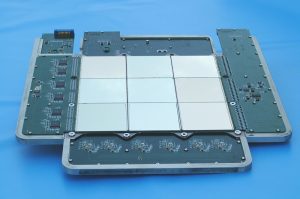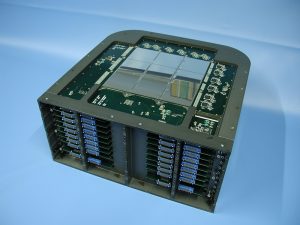 The sampling imaging electromagnetic calorimeter comprises 44 single-sided silicon sensor planes (380 μ m thick) interleaved with 22 plates of tungsten absorber. Each tungsten layer has a thickness of 0.26 cm, which corresponds to 0.74 X0 (radiation lengths), giving a total depth of 16.3 X0 ( ~ 0.6 nuclear interaction lengths). Each silicon plane is composed of a 3×3 matrix of (8×8) cm2 silicon detectors, each segmented into 32 read-out strips with a pitch of 2.4 mm. The orientation of the strips of two consecutive layers is orthogonal and therefore provides two-dimensional spatial information.
The sampling imaging electromagnetic calorimeter comprises 44 single-sided silicon sensor planes (380 μ m thick) interleaved with 22 plates of tungsten absorber. Each tungsten layer has a thickness of 0.26 cm, which corresponds to 0.74 X0 (radiation lengths), giving a total depth of 16.3 X0 ( ~ 0.6 nuclear interaction lengths). Each silicon plane is composed of a 3×3 matrix of (8×8) cm2 silicon detectors, each segmented into 32 read-out strips with a pitch of 2.4 mm. The orientation of the strips of two consecutive layers is orthogonal and therefore provides two-dimensional spatial information.
The front-end is a developed version of a 16 channels CR1 chip with a peaking time of 2 ms, a linear dynamic range between 0.4 and 1200 MIPs, a sensitivity of 5 mV/MIP and a counting rate of 30 kHz. The total number of channels is 4416. The calorimeter has a mass of 110 Kg and a total power consumption of 75 W.
 The longitudinal and transverse segmentation of the calorimeter, combined with the measurement of the particle energy loss in each silicon strip, allows a rejection power of electrons (in the antiprotons sample) and protons (in the positrons sample) is better than 104 with an efficiency of 90%.
The longitudinal and transverse segmentation of the calorimeter, combined with the measurement of the particle energy loss in each silicon strip, allows a rejection power of electrons (in the antiprotons sample) and protons (in the positrons sample) is better than 104 with an efficiency of 90%.
The calorimeter allows also to reconstruct the energy of the electromagnetic shower, providing a measurement of the energy of the incident electrons up to several hundred GeV with a resolution of the order of 5.5%.
